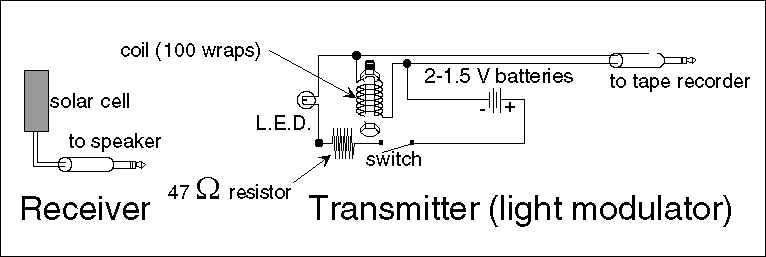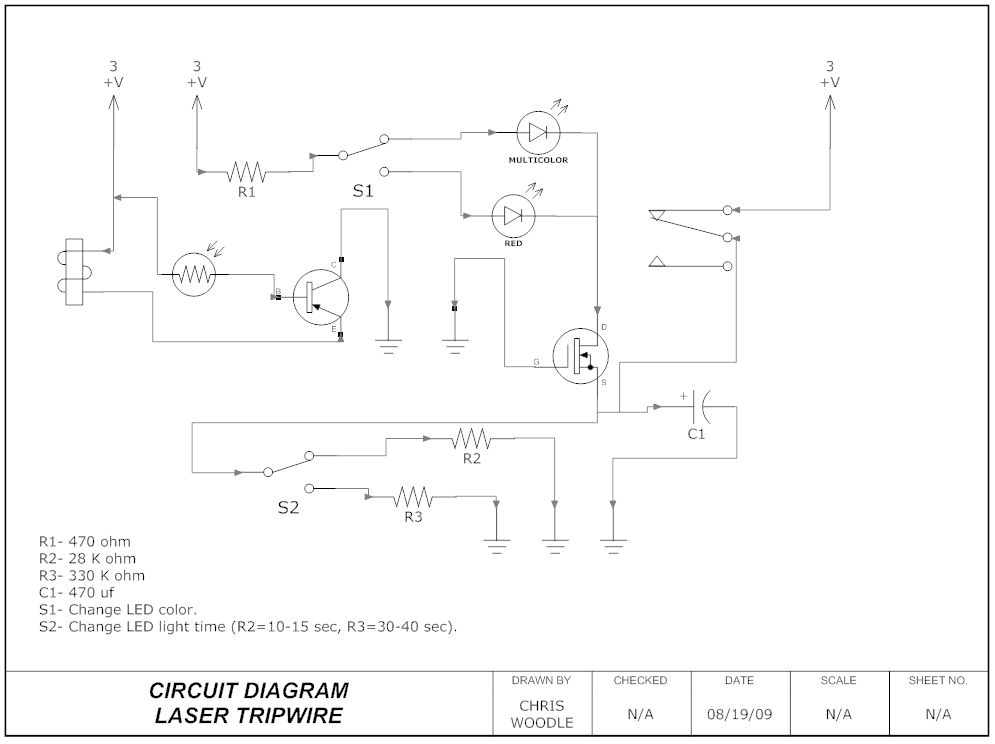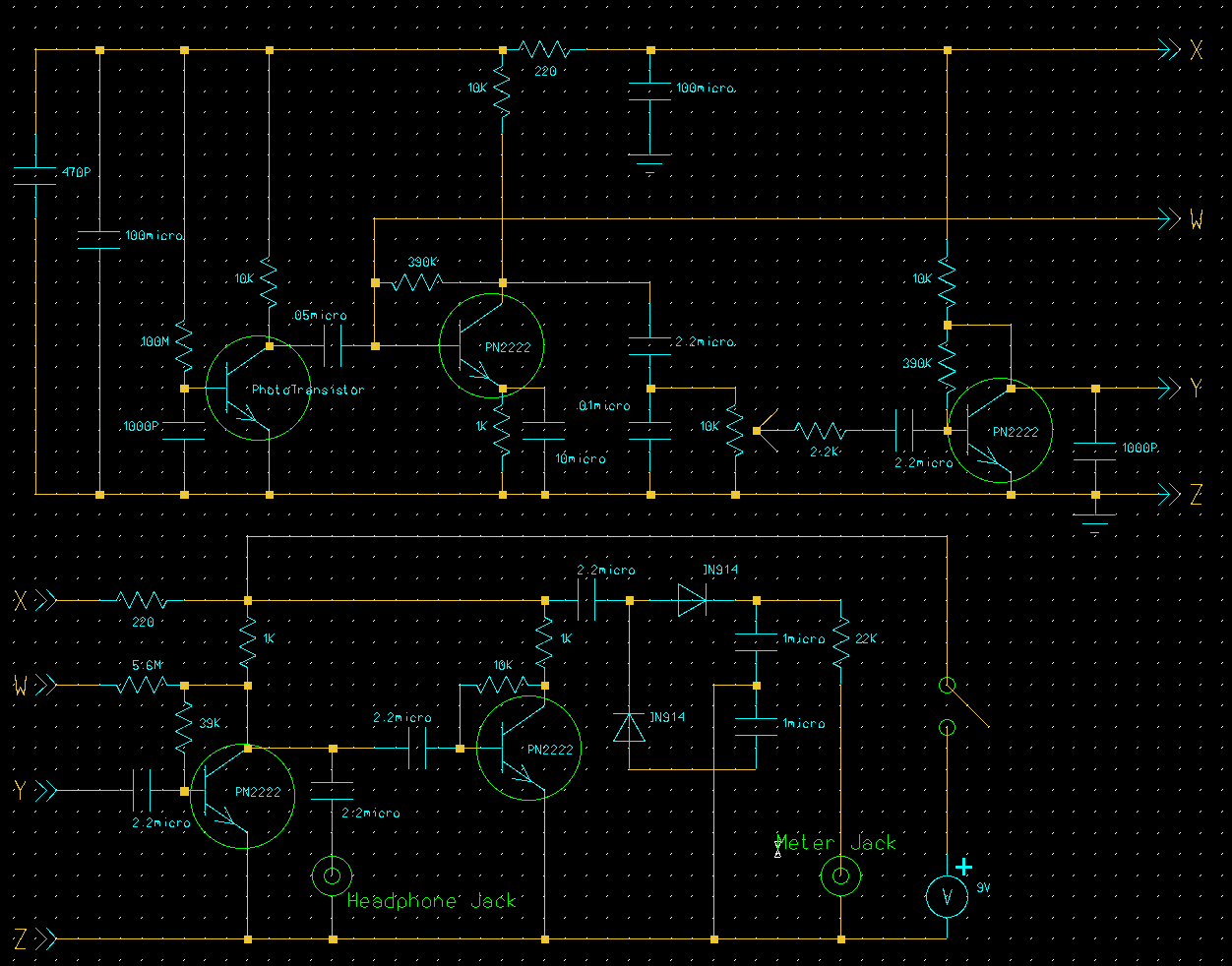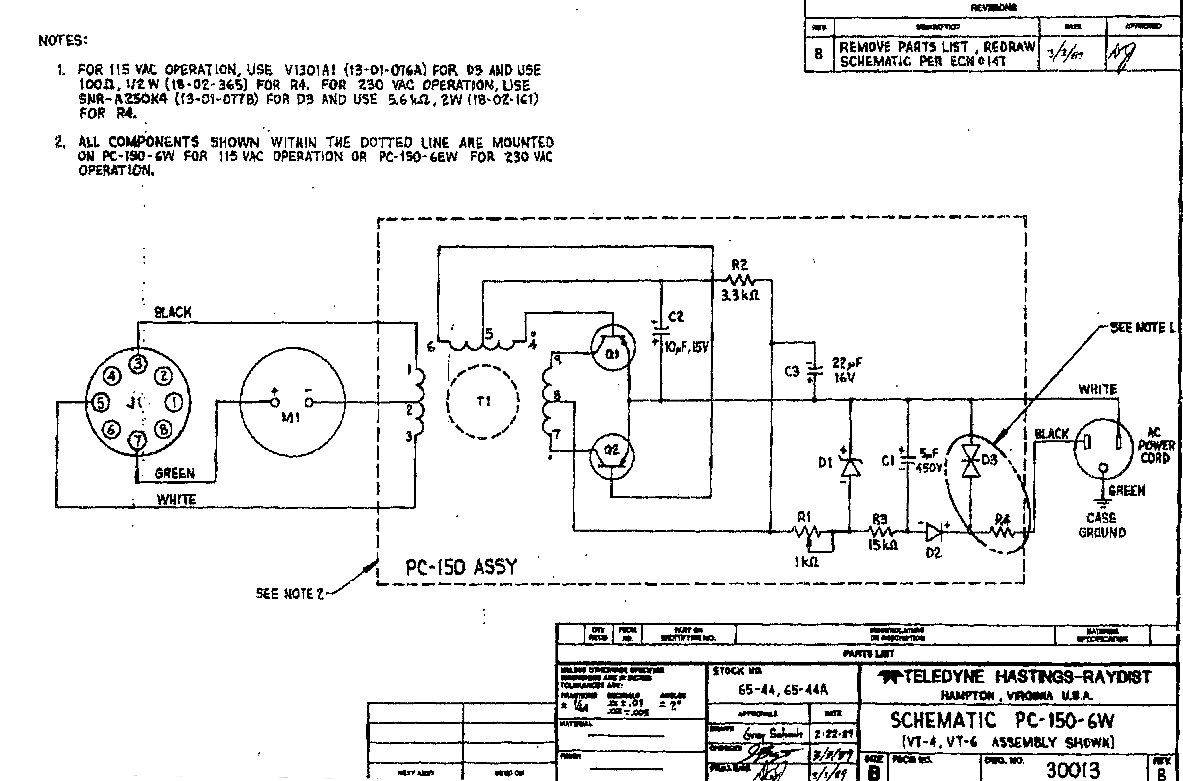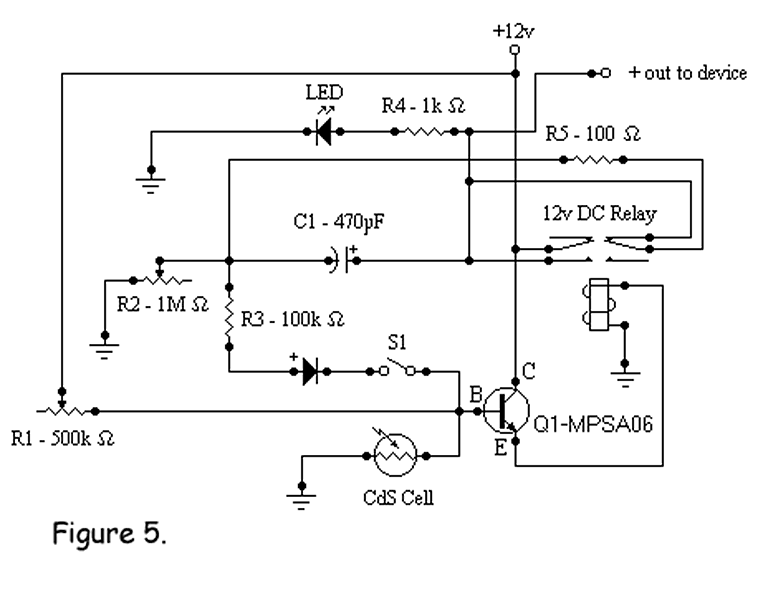
Home-Built Nitrogen (N2) Laser
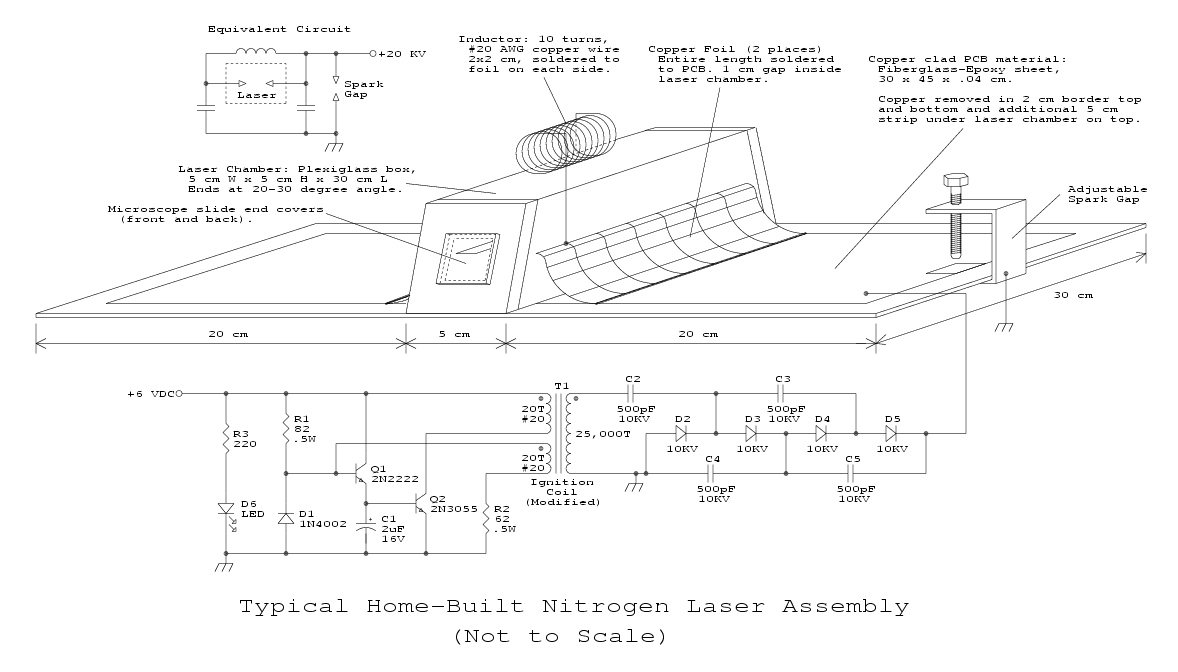
The nitrogen (N2) laser generates extremely short pulses of light (lasting a few nanoseconds) with a typical intensity of 100 kW in the near ultraviolet (UV) range of the electromagnetic spectrum, specifically at 337.1 nm. Despite its impressive capabilities, the N2 laser is relatively easy to construct for several reasons: mirrors are not necessary, as the gain of the nitrogen lasing medium is sufficiently high that a single pass through the discharge chamber produces an intense coherent UV pulse. A totally reflecting mirror can be added at the far end of the chamber to double the output by reflecting the portion of the beam that would otherwise exit the chamber. However, a true resonator with a pair of mirrors does not significantly enhance performance, as the lasing process is self-limiting and concludes within a few nanoseconds. The basic pulse power supply is straightforward and relatively safe compared to other home-built lasers. An optional high-performance power supply can be used to enhance average power but is not essential. Among home-built lasers, the nitrogen laser likely has the lowest risk of failure if constructed according to the Scientific American design. This design avoids the complexities of glass working, mirror mounts, and alignment, requiring minimal vacuum. The resulting laser is not substantially inferior to commercial units costing significantly more, though it may lack certain convenience features. The UV output is not as tightly focused as that of HeNe or CO2 lasers, making it unsuitable for materials processing, but it can effectively pump dye lasers and serve various applications requiring intense UV light, with appropriate safety precautions against UV exposure. Despite its apparent simplicity, it is crucial not to improvise before successfully constructing the SciAm design, as even this straightforward laser requires careful assembly. The dimensions, materials, and construction techniques should closely follow the original design to ensure success. Once operational, experimentation is encouraged, but changes should be made incrementally. In addition to being a suitable first laser for enthusiasts, N2 lasers have applications in optical pumping of dye lasers, UV spectroscopy, non-destructive testing, fluorescence measurements, and high-speed photography using nanosecond UV strobe techniques. The laser outputs at 337.1 nm, producing ultra-violet radiation in the UVA region of the electromagnetic spectrum. While the peak output can exceed 100 kW, the pulse duration is limited to a few nanoseconds. The pulse repetition rate for the SciAm design can range from one pulse every few seconds (using a DC powered high-voltage inverter) to several pulses per second (up to 120) when using a neon sign transformer-based power supply. A 5 ns pulse at 100 kW delivers an energy output of 0.5 mJ, which, while modest, remains a potent energy level.
The N2 laser operates based on the principles of gas discharge and stimulated emission. The core component is the nitrogen gas, which is excited by an electrical discharge, leading to population inversion and subsequent laser action. The discharge chamber is typically constructed from materials capable of withstanding high voltages and pressures, such as glass or metal. The design must ensure efficient gas flow and maintain the integrity of the discharge path to facilitate optimal lasing conditions.
To construct the N2 laser, the following components are essential:
1. **Discharge Chamber**: This is where the nitrogen gas is contained. It should be designed to allow for easy access to the electrodes while maintaining a vacuum or low-pressure environment to prevent contamination.
2. **Electrodes**: These are typically made from conductive materials such as copper or aluminum, positioned at either end of the discharge chamber. The electrodes must be capable of withstanding high voltages to create the necessary electrical discharge.
3. **Power Supply**: A high-voltage power supply is crucial for exciting the nitrogen gas. Options include DC high-voltage inverters or neon sign transformers, with the latter providing higher pulse repetition rates.
4. **Cooling System**: While not always necessary, a cooling system may be employed to manage heat generated during operation, especially if the laser is used continuously.
5. **Safety Features**: Given the UV output, appropriate safety measures must be implemented, including UV-blocking shields and warning indicators to prevent accidental exposure.
6. **Output Coupler (Optional)**: While not essential, a UV-reflecting mirror can be added to increase output power by reflecting the beam back into the discharge chamber.
The construction process should follow a systematic approach, starting with the assembly of the discharge chamber and electrodes, followed by the installation of the power supply and any additional components. Testing should be conducted at each stage to ensure proper functionality and safety compliance. Once operational, the N2 laser can be utilized in various applications, taking advantage of its unique properties while adhering to safety protocols.The nitrogen (N2) laser produces intense extremely short (a few ns) intense (100 kW typical) pulses of light in the near UV portion of the E/M spectrum (337. 1 nm). Despite this impressive capability, the N2 laser is among the easiest to construct for the following reasons: Mirrors are NOT required.
The gain of the lasing medium (N2) is so high tha t one pass through the discharge chamber is sufficient to produce an intense coherent UV pulse. A totally reflecting mirror of almost any type as long as it reflects UV can be added at the far end of the chamber to double the output if desired. All it is doing is reflecting the half of the beam that would be otherwise lost out the other end of the box.
In fact, a true resonator with a pair of mirrors would not help much at all. The lasing process is self limiting so all the exciting action is over in a few nanoseconds! The basic pulse power supply is very simple and not terribly dangerous (in a relative sort of way compared to most other home-built lasers). A higher performance (and more dangerous) power supply is an option to boost average power but is not required.
Compared to all the other home-built lasers, the nitrogen laser also likely has the lowest risk of failure IFF you stay pretty close to the SciAm design, more below. No glass working, no mirrors, mirror mounts, or mirror alignment, minimal vacuum. Despite this, what you end up with isn`t substantially inferior to a commercial unit costing many kilobucks.
It just lacks the convenience features and other bells and whistles. Now, the UV output isn`t in a tight high quality beam like that of an HeNe or CO2 laser but it is a real laser. So, despite the high peak power, due to the lack of beam quality, the N2 laser isn`t going to be good for materials processing since it is very difficult to focus the N2 laser beam to a small spot.
However, it can be used to pump a dye laser and for all sorts of other applications requiring intense UV (and safety precautions must be taken to guard against excessive UV exposure). However, despite the apparent simplicity of the N2 laser, don`t be tempted to improvise before you get the SciAm design to lase.
Even this simple laser can`t just be thrown together (despite what you might think from the humor in the section: Nitrogen Laser Construction on a Shoestring - this should not be taken seriously). Start out with the same dimensions, materials, and construction techniques, and success is almost certain.
While the SciAm N2 laser is not necessarily optimal or the highest power possible, it does work. Bigger is not necessarily better (or higher power but may actually be 0. 00 power. You can`t just increase the size of the capacitors and laser tube and expect it to do anything useful). Once your N2 laser is operational, feel free to go hog wild expermenting. But even then, change only one thing at a time! In case you are wondering, N2 lasers do have their uses besides being a good first laser for the home-built laser enthusiast.
These include: optical pumping of dye lasers, UV spectroscopy, non-destructive testing, fluorescence measurements of materials, and measurements of very fast processes (nanosecond UV strobe for high speed photography). Perhaps, these are not as glamorous as laser light shows and laser welding, but important applications nonetheless!
Laser output: The home-built N2 laser operates at 337. 1 nm producing pulses of ultra-violet radiation in the UVA region of the electromagnetic spectrum. While its peak output may be 100 kW or more, the pulse duration is only a few nanoseconds at most. The pulse repetition rate (for the SciAm design, at least) may be anywhere from one pulse every few seconds (using the DC powered HV inverter) to several (maybe as much as 120) per second (using a neon sign transformer based power supply). A 5 ns 100 kW pulse has an energy of. 5 mJ which may not sound like a lot but is still a potent 🔗 External reference
The N2 laser operates based on the principles of gas discharge and stimulated emission. The core component is the nitrogen gas, which is excited by an electrical discharge, leading to population inversion and subsequent laser action. The discharge chamber is typically constructed from materials capable of withstanding high voltages and pressures, such as glass or metal. The design must ensure efficient gas flow and maintain the integrity of the discharge path to facilitate optimal lasing conditions.
To construct the N2 laser, the following components are essential:
1. **Discharge Chamber**: This is where the nitrogen gas is contained. It should be designed to allow for easy access to the electrodes while maintaining a vacuum or low-pressure environment to prevent contamination.
2. **Electrodes**: These are typically made from conductive materials such as copper or aluminum, positioned at either end of the discharge chamber. The electrodes must be capable of withstanding high voltages to create the necessary electrical discharge.
3. **Power Supply**: A high-voltage power supply is crucial for exciting the nitrogen gas. Options include DC high-voltage inverters or neon sign transformers, with the latter providing higher pulse repetition rates.
4. **Cooling System**: While not always necessary, a cooling system may be employed to manage heat generated during operation, especially if the laser is used continuously.
5. **Safety Features**: Given the UV output, appropriate safety measures must be implemented, including UV-blocking shields and warning indicators to prevent accidental exposure.
6. **Output Coupler (Optional)**: While not essential, a UV-reflecting mirror can be added to increase output power by reflecting the beam back into the discharge chamber.
The construction process should follow a systematic approach, starting with the assembly of the discharge chamber and electrodes, followed by the installation of the power supply and any additional components. Testing should be conducted at each stage to ensure proper functionality and safety compliance. Once operational, the N2 laser can be utilized in various applications, taking advantage of its unique properties while adhering to safety protocols.The nitrogen (N2) laser produces intense extremely short (a few ns) intense (100 kW typical) pulses of light in the near UV portion of the E/M spectrum (337. 1 nm). Despite this impressive capability, the N2 laser is among the easiest to construct for the following reasons: Mirrors are NOT required.
The gain of the lasing medium (N2) is so high tha t one pass through the discharge chamber is sufficient to produce an intense coherent UV pulse. A totally reflecting mirror of almost any type as long as it reflects UV can be added at the far end of the chamber to double the output if desired. All it is doing is reflecting the half of the beam that would be otherwise lost out the other end of the box.
In fact, a true resonator with a pair of mirrors would not help much at all. The lasing process is self limiting so all the exciting action is over in a few nanoseconds! The basic pulse power supply is very simple and not terribly dangerous (in a relative sort of way compared to most other home-built lasers). A higher performance (and more dangerous) power supply is an option to boost average power but is not required.
Compared to all the other home-built lasers, the nitrogen laser also likely has the lowest risk of failure IFF you stay pretty close to the SciAm design, more below. No glass working, no mirrors, mirror mounts, or mirror alignment, minimal vacuum. Despite this, what you end up with isn`t substantially inferior to a commercial unit costing many kilobucks.
It just lacks the convenience features and other bells and whistles. Now, the UV output isn`t in a tight high quality beam like that of an HeNe or CO2 laser but it is a real laser. So, despite the high peak power, due to the lack of beam quality, the N2 laser isn`t going to be good for materials processing since it is very difficult to focus the N2 laser beam to a small spot.
However, it can be used to pump a dye laser and for all sorts of other applications requiring intense UV (and safety precautions must be taken to guard against excessive UV exposure). However, despite the apparent simplicity of the N2 laser, don`t be tempted to improvise before you get the SciAm design to lase.
Even this simple laser can`t just be thrown together (despite what you might think from the humor in the section: Nitrogen Laser Construction on a Shoestring - this should not be taken seriously). Start out with the same dimensions, materials, and construction techniques, and success is almost certain.
While the SciAm N2 laser is not necessarily optimal or the highest power possible, it does work. Bigger is not necessarily better (or higher power but may actually be 0. 00 power. You can`t just increase the size of the capacitors and laser tube and expect it to do anything useful). Once your N2 laser is operational, feel free to go hog wild expermenting. But even then, change only one thing at a time! In case you are wondering, N2 lasers do have their uses besides being a good first laser for the home-built laser enthusiast.
These include: optical pumping of dye lasers, UV spectroscopy, non-destructive testing, fluorescence measurements of materials, and measurements of very fast processes (nanosecond UV strobe for high speed photography). Perhaps, these are not as glamorous as laser light shows and laser welding, but important applications nonetheless!
Laser output: The home-built N2 laser operates at 337. 1 nm producing pulses of ultra-violet radiation in the UVA region of the electromagnetic spectrum. While its peak output may be 100 kW or more, the pulse duration is only a few nanoseconds at most. The pulse repetition rate (for the SciAm design, at least) may be anywhere from one pulse every few seconds (using the DC powered HV inverter) to several (maybe as much as 120) per second (using a neon sign transformer based power supply). A 5 ns 100 kW pulse has an energy of. 5 mJ which may not sound like a lot but is still a potent 🔗 External reference

